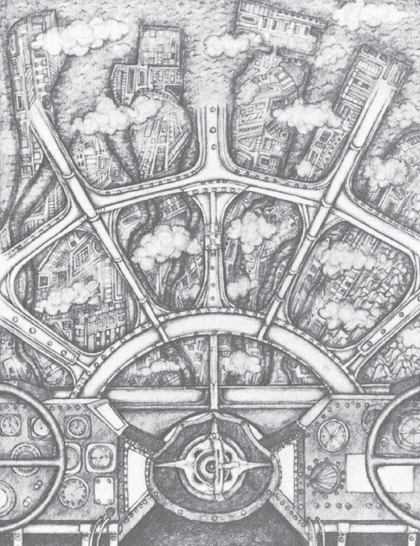Drawing by Cecily Moon for American Realities
from "Total War, The Bombing of Hiroshima" American Realities, Volume II (click to see more on Hiroshima on this site.)
In the predawn hours of August 6, 1945, three American B-29s droned through the darkness bound north from the Pacific island of Tinian toward the Japanese coastal town of Hiroshima. They flew at four thousand feet, where the air was close and humid, to avoid colliding with one of the hundreds of B-29s returning from bombing runs over Japan. Such massive raids were common. In the past year the balance of terror in the Pacific had swung irreversibly to the American side, and in summer 1945, B-29 Superfortresses could blast and burn Japanese cities almost at will. In comparison to such huge congregations of destruction, the three low-flying planes seemed unobtrusive, all but harmless. Not only were they few, but they did not bristle with guns like the other B-29s. Among them they carried only one bomb. Aboard the three planes there was little to suggest the historic character of the mission. The Great Artiste, so named for its commander’s reputed prowess in love, carried a cargo of scientific instruments. A second ship, called simply Number 91, was full of photographic equipment. The third craft, named Enola Gay after its pilot’s mother, carried the bomb. Until recently only the lead pilot, Lt. Col. Paul W. Tibbets Jr., had known the character of this strange object they were soon to drop on Japan....
I am working this summer with three talented research assistants creating the web site of which this blog is a part. One of our goals is to put materials on line for each of my five books. Lee Nilsson created this Google map locating key places in the story of Hiroshima as described in my essay “Total War” in American Realities. Click on the pins on the map below for related images and text from the essay. Click on the link beneath the map ("View American Realities - Total War in a larger map") here or beneath this image for a larger map with more functionalities.
View American Realities - Total War in a larger map
View more entries on the American Realities blog...
(You know you want to!)
.


 RSS Feed
RSS Feed